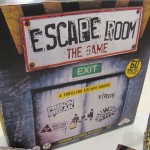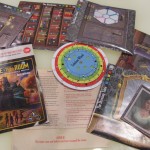2018 Scoreboard
01 Jan
Posted by David Miller as CCGs, Classic Board Games, Electronic Games, Modern Board Games, Other
 A group of senior high school students at the American British Academy in Muscat set a new record for computer processor built from dominoes. With 15,000 dominoes, they constructed a 5-bit adder that can sum numbers up to 63. [For a fascinating explanation of how this works, I suggest this video from the person who built the 4-bit adder.]
A group of senior high school students at the American British Academy in Muscat set a new record for computer processor built from dominoes. With 15,000 dominoes, they constructed a 5-bit adder that can sum numbers up to 63. [For a fascinating explanation of how this works, I suggest this video from the person who built the 4-bit adder.]
Keisuke Fukuchi of Japan took home the trophy at the World Othello Championship held in Prague, Czech Republic. At 11 years of age, he’s the youngest champion ever in the tournament’s 42 year history. On his flight home via All Nippon Airways, a congratulations was announced by the pilot, Kunihiko Tanida, the previous record holder for youngest Othello champion (which he had held since 1982).
 The World Chess Hall of Fame in St. Louis reclaimed the record for the world’s largest Chess piece. It previously held the record with a 14 foot tall king from 2012 to 2014 but was then eclipsed by a school in the town of Kalmthout, Belgium. The new record-making piece is a 20 foot tall black Staunton king with a base of 9 feet 2 inches and a weight of 10,860 pounds. It was hand carved from African Sapele Mahogany.
The World Chess Hall of Fame in St. Louis reclaimed the record for the world’s largest Chess piece. It previously held the record with a 14 foot tall king from 2012 to 2014 but was then eclipsed by a school in the town of Kalmthout, Belgium. The new record-making piece is a 20 foot tall black Staunton king with a base of 9 feet 2 inches and a weight of 10,860 pounds. It was hand carved from African Sapele Mahogany.
Magnus Carlsen of Norway successfully defended his World Chess Champion title against Fabiano Caruana of the United States by intentionally playing for a draw in standard time controls and then winning three straight in rapid tie-breaks. At the World Rapid Chess Championship, though, Carlsen tied with three others for second place. The winner in that event was Daniil Dubov of Russia. Following that was the World Blitz Chess Championship, where Carlsen again came out on top.
With a win at the London Chess Classic, Hikaru Nakamura of the United States secured first place in the multi-tournament Grand Chess Tour series.
Among artificial entities, Chess engine Stockfish won both Rapid and Blitz categories of the Chess.com Computer Chess Championship. Houdini came in second in Rapid, where the final match took place over 200 games, and Komodo came in second in Blitz, where the final was 300 games.
Nigel Richards won his fourth World Scrabble Championship with a final game score of 575-452, that achieved with such words as “groutier” (68 points), “zonular” (100 points), and “phenolic” (84 points). His opponent managed “maledict” for 95 points.
A new edition of The Official Scrabble Players Dictionary makes legal play out of “sheeple”, “ew”, “OK”, “yowza”, and “zomboid”. It also adds another q-without-a-u word, “qapik”, a monetary unit from Azerbaijan.
Javier Dominguez of Spain, who last year finished in second place, managed a win in this year’s finals, taking home $100,000 and the trophy for Magic: The Gathering World Champion.
Akiko Yazawa of Japan, cancer survivor, won her second World Backgammon Championship title.
Topping a field of 76 contestants from 46 countries, Quetzal Hernandez of Mexico won the Catan World Championship in Cologne, Germany.
Elena Short of Ukraine finished first in both the women’s classic and women’s blitz sections of the World Championship in Draughts 64.
Wu Yiming, 11 years old, of China became the country’s youngest female professional Go player.
In late December 2017, thirteen year-old Que Jianyu appeared on Chinese television and solved three Rubik’s Cubes while continuously juggling them, and did so in a world record 5 minutes 6.61 seconds. Then in December of this year, he went on Italian television and broke his own record by just over 4 seconds. Between these two events, he also broke speed records for solving three Rubik’s Cubes simultaneously with hands and feet (1 minutes 36.39 seconds) and solving a single Rubik’s cube while hanging upside down (15.84 seconds).
At the Cube for Cambodia event in Melbourne, Australia, Feliks Zemdegs solved a 3×3 Rubik’s Cube in a world record 4.22 seconds.
Max Park of the United States set four new Rubik’s Cube world records. He solved:
- 4×4 in 18.42 seconds and 5×5 in 37.28 seconds at SacCubing in Roseville, California.
- 6×6 in 1 minute 13.82 seconds at WCA Asian Championship in New Taipei City, Taiwan.
- 7×7 in 1 minute 47.89 seconds at West Coast Cubing Tour in Fresno, California.
Several new world records were set for solving Rubik’s Cubes while blindfolded. At the end of the year, the records stand as follows:
- 16.55 seconds for 3×3 blindfolded, set by Max Hilliard at the Puget Sound NxNxN in Tacoma, Washington.
- 1 minute 26.41 seconds for 4×4 blindfolded set by Kaijun Lin at the Please Be Quiet Beijing in Beijing, China.
- 3 minutes 1.01 seconds for 5×5 blindfolded set by Stanley Chapel at the Shaker Fall in Shaker Heights, Ohio.
Grégoire Pfennig of Belfort, France built the largest order working Rubik’s Cube puzzle, 33×33. Imagine how long it would take to solve that!
A group of four in Moscow set a world record for the number of escape rooms attended in 1 day, 22.
At the World Rummikub Championship in Jerusalem, Kohei Numajiri of Japan came in first place, Sasha Erlich of Israel came in second, and Matthijs Delvers of Netherlands third.
Ankush Khandelwal of the U.K. won the Pentamind World Championship, a tournament that consists of matches in Quoridor, 7 Wonders, Acquire, Liar’s Dice, and Chess 960.
Brain Games held its first ICECOOL World Championship event at BaltiCon in Riga, Latvia, where Khanh Hung Dong of Canada took home the trophy and a prize of a weekend for two at Snow Village in Lapland.

- Comments Off on 2018 Scoreboard

Clue Chase, which operates several escape rooms in Midtown Manhattan, is launching Escape-To-Go, a live puzzle activity that can be played at the customer’s location. For Contagion, the first story-line offered, actors provide guidance to individual teams as they work to solve puzzles that represent finding and disabling devices armed with deadly pathogens.
Clue Chase says its Escape-To-Go service can support groups of to 500 people split into teams across multiple tables. Each team is given a central item, such as “specially rigged devices [or] briefcases with hidden compartments”, and a variety of puzzles. The event is timed to last 70 minutes.
- Comments Off on Large-Group Escape Room To-Go
 A team from Slovenia won the Red Bull Mind Gamers’ first Escape Room World Championship, which featured some really high-end set design (including a rotating tunnel) and challenges themed around quantum computing. The escape-rooms were designed by Prof. Scott Nicholson and his students at Wilfrid Laurier University. Held this past week in Budapest, the event ran more than 20 international teams through a series of timed challenges, with the top two teams, Slovenia and Ukraine, moving to the finals. There, the teams’ performance on a series of additional challenges—including one that surprised the competitors by needing to be solved cooperatively—determined the difficulty level assigned to them in a final puzzle.
A team from Slovenia won the Red Bull Mind Gamers’ first Escape Room World Championship, which featured some really high-end set design (including a rotating tunnel) and challenges themed around quantum computing. The escape-rooms were designed by Prof. Scott Nicholson and his students at Wilfrid Laurier University. Held this past week in Budapest, the event ran more than 20 international teams through a series of timed challenges, with the top two teams, Slovenia and Ukraine, moving to the finals. There, the teams’ performance on a series of additional challenges—including one that surprised the competitors by needing to be solved cooperatively—determined the difficulty level assigned to them in a final puzzle.

The inaugural season of the PRO Chess League has concluded with the St. Louis Arch Bishops taking the championship title. St. Louis, led by the world’s number 2-ranked player Wesley So, faced in the final match the Norway Gnomes, led by number 1, World Chess Champion Magnus Carlsen. So also captured the medal for MVP.
Also hailing from St. Louis, the Webster University Chess team won its fifth consecutive President’s Cup Collegiate Chess Tournament in New York City (fondly known as the Chess Final Four). Coach Susan Polgar was quoted as saying, “This was an incredibly hard victory, and the students gave everything they had. The competition on Saturday lasted nearly 13 hours, underscoring the importance of both physical and mental toughness.”
At the Cubing Classic in Melbourne, Australia, Feliks Zemdegs solved a 7×7 Rubik’s Cube in a world record 2 minutes, 18.13 seconds.
A Michigan team by the name of Incredible Science Machine has broken the world record for number of dominoes (76,017) toppled from the center in a circle field. The circle was the final display in a longer domino-toppling series that started with a Rube Goldberg-type trigger and included separate sections dedicated to each of Earth’s continents.
 Red Bull TV is sponsoring a mind games tournament they’re calling the Escape Room World Championship. Scheduled for March 25th in Budapest, the event will see 20 international teams compete in a room based on “quantum logic” designed by Scott Nicholson.
Red Bull TV is sponsoring a mind games tournament they’re calling the Escape Room World Championship. Scheduled for March 25th in Budapest, the event will see 20 international teams compete in a room based on “quantum logic” designed by Scott Nicholson.
- Comments Off on Escape Room World Championship
Escape rooms, one of the hottest new trends in entertainment, are a kind-of live adventure game. Participants are locked in a room or similar location and given usually about an hour to solve puzzles and follow a series of clues that finds the key and lets them out. Most are built around a theme or story and designed for groups of 4-6 friends.
But though escape rooms are popping up in many urban locations, they’re not accessible to many people, can sometimes be difficult to schedule, and can cost a hundred dollars or more for a 1 hour session. Enter several companies offering escape rooms to go.
Developed by Identity Games and licensed for North American distribution by Spin Master, Escape Room The Game is a $40 package due in the summer that can run 2-5 participants through four different rooms. The clues, puzzles, and mysteries for each room are contained in three envelopes. When participants believe they have solved an envelope, they choose one of the included keys and plug it in to the game’s electronic timer, called a “chrono decoder”. If they’re correct, they can move on to the next envelope. If not, the chrono decoder imposes a time penalty. Though the base game is not yet at retail, Identity is already at work on expansion packs, which should make use of the same chrono decoder.
Another at-home option, ThinkFun’s Escape the Room: Mystery at the Stargazer’s Manor, addresses the problem of hiding answers with a “solution wheel” rather than something electronic. The game begins with the reading of a scene card and proceeds along a story line. Every puzzle solved on the way leads to a symbol and those symbols have to line up in a certain way on the wheel in order to trigger the next stage of the mystery. Due in March, Mystery at the Stargazer’s Manor is just a single room activity but is timed at 90 minutes and priced at only $22.
There’s also the Escape Room In A Box: The Werewolf Experiment Kickstarter project. At $45, this one is also only a single room game. However, it is a more handcrafted experience with jars, locks, and other more substantial elements. Also, certain replacement parts will be available, so that the kit can be used to host other teams.

- Comments Off on Escape Rooms on the Go
Trending
- Massdrop.com
- Oh the Irony—Illuminati Card Game Continues to Inspire Conspiracy Theorists
- Footprints, an Educational Ecology Game
- Home
- USPS Adds Board Game Flat Rate Box
- Baila, the Estonian Drinking Card Game
- Crystal Caste Wins Dice Patent Suit Against Hasbro
- Mirror Game, Red and Blue
- Are Board Games Dangerous?
- Board Games Based on Hindu Mythology
Archives
Most Popular Articles
- Oh the Irony—Illuminati Card Game Continues to Inspire Conspiracy Theorists
- The 20 Most Valuable Vintage Board Games
- The Truth About Dominoes On Sunday in Alabama
- Sequence Game, and Variants
- USPS Adds Board Game Flat Rate Box
- Baila, the Estonian Drinking Card Game
- The 13 Most Popular Dice Games
- Are Board Games Dangerous?
- Guess Who? The Naked Version
- What Happened to the Jewel Royale Chess Set?
Recent Posts
- Toy Fair 2019—Breaking Games
- Talisman Kingdom Hearts Edition
- Toy Fair 2019—Winning Moves
- Toy Fair 2019—Games Workshop
- Toy Fair 2019—Star Wars Lightsaber Academy
- Toy Fair 2019—Stranger Things Games
- Toy Fair 2019—HABA
- Licensing Roundup
- Game Bandit
- 2018 A Difficult Year For Hasbro But Not For D&D Or MtG
Recent Comments
- on Toy Fair 2019—Winning Moves
- on Game Bandit
- on Second Look—Dungeons & Dragons Waterdeep Dragon Heist
- on Crowdfunding Highlights
- on Beyblade SlingShock
- on Game Bandit
- on Game Bandit
- on Watch This Game!, the Board Game Review Board Game
- on Second Look—Vampire: The Masquerade 5th Edition
- on Palladium Books Loses Robotech IP License, Cancels Five-Year-Overdue Robotech RPG Tactics Kickstarter









